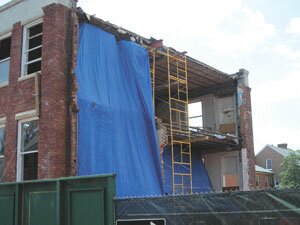ONARCHITECTURE- <i>Way</i> complicated: Courthouse dust still swirling

The Problem: On March 30, 2006 the north-east corner of the Juvenile & Domestic Relations Court building collapsed as workers dug near its foundation. PHOTO BY DAVE MCNAIR
While the actual dust from last year's collapse of the old Juvenile & Domestic Relations Court building on High Street has long since settled, it appears the dust of the legal and financial argument over whose fault it was is still swirling.
"This one is way complicated," says Board of Architectural Review vice chair Syd Knight, "not only with structural concerns, but with legal and financial concerns as well." Indeed, BAR chair Fred Wolf echoes Knight's comments.
Court Square watchers have noticed that the scaffolding that had been securing the collapsed corner of the courthouse has been removed. After an engineering study, BAR review, and further negotiations between the contractor, Kenbridge Construction, and the City, the $12.4 million renovation project got under way again in mid-June. However, according to city attorney Craig Brown, the argument over who should bear responsibility for the collapse is far from over.
As Brown told the Hook in May, it's the City's position that the collapse was the fault of Kenbridge and its subcontractors. Brown says they had hoped to work things out in mediation.
"But that failed," he says. While the renovation is moving forward, it appears the City and Kenbridge could be headed for a showdown.
"At some point, [Kenbridge] will present us with a bill," says Brown. "...and we will decline to pay it. Then we'll have to take it from there."
As Brown points out, there are a number of parties involved in the argument, including the City, the County, Kenbridge, its subcontractors, and an engineering consultant.
"Obviously, all those parties have insurance companies," says Brown. "It will all have to be sorted out."
Meanwhile, the practicality of finishing the project comes with its share of controversy as well. At first glance, it appears the collapsed corner has been meticulously repaired, but a closer look reveals that something's missing.
Rather than repairing the corner, the City elected to demolish the entire north end of the building, 22 feet in all.
Ironically, the solution to repairing the collapse was to demolish more of the building than the collapse destroyed.
"Removing the entire back was presented to the BAR as the best of a number of unattractive options," says Knight. "Sure, in a perfect world, we would have preferred that they rebuild."
"Cost was a big driver," admits City capital projects director Mike Mollica. "It was more economical to demolish the back of the building."
However, as Mollica explains, the chosen demo plan (which was the chosen plan of the structural engineers who studied the building, he says) isn't going to alter the look of the building all that much. The original design called for the north wall to be included "inside" the building anyway, he says, as new construction will extend the back of the building. He also says the demo option will help keep the project on schedule.
"Since the back of the building is going to be partially obscured by the new construction," Knight says, "removing and replacing the remainder seemed to be a reasonable compromise."
Neither Mollica or Brown can say what the eventual cost might be, or who will be responsible for it, pending resolution of the question of responsibility for the collapse, but for now Mollica says the $12.4 contract with Kenbridge hasn't changed.
At a BAR meeting earlier this year, one concerned citizen suggested that demolishing the courthouse would have been a better idea than "dragging it out for years" trying to save it. As the citizen pointed out, the building was in terrible shape. Indeed, lots of people said they were not surprised that it collapsed, since only the thin brick facade was being preserved, a facade so fragile that one could see light between the bricks at the time of the collapse.
Preservationists haven't been happy about the project either. While they would never have recommended demolition, they found the facade-saving effort inadequate. In a letter to city councilors last year, Piedmont Preservation used the courthouse collapse to criticize a process they call "facadism."
"A new building fashioned out of scavenged rubble is not a historic structure," they wrote. "It's a loss against which no insurance policy can protect."
Indeed, according to Mollica, the salvaged brick on the site will be used to make the side walls blend in with the new construction.
If the city can navigate smoothly through all the complicated legal, financial, and structural obstacles ahead, Mollica says the new courthouse could be finished by December 2008.

The Solution: In June 2007, the City chose to demolish 22 feet off the back of the courthouse rather than rebuild the collapsed corner.
PHOTO BY DAVE MCNAIR
#